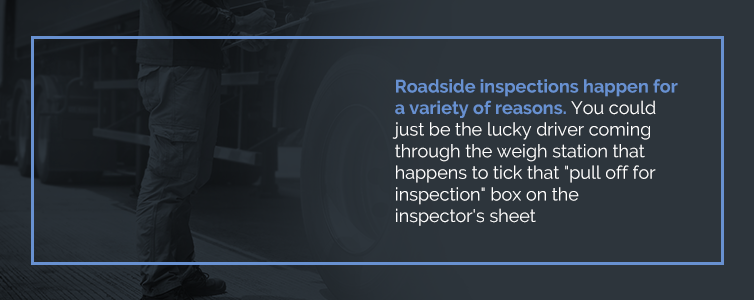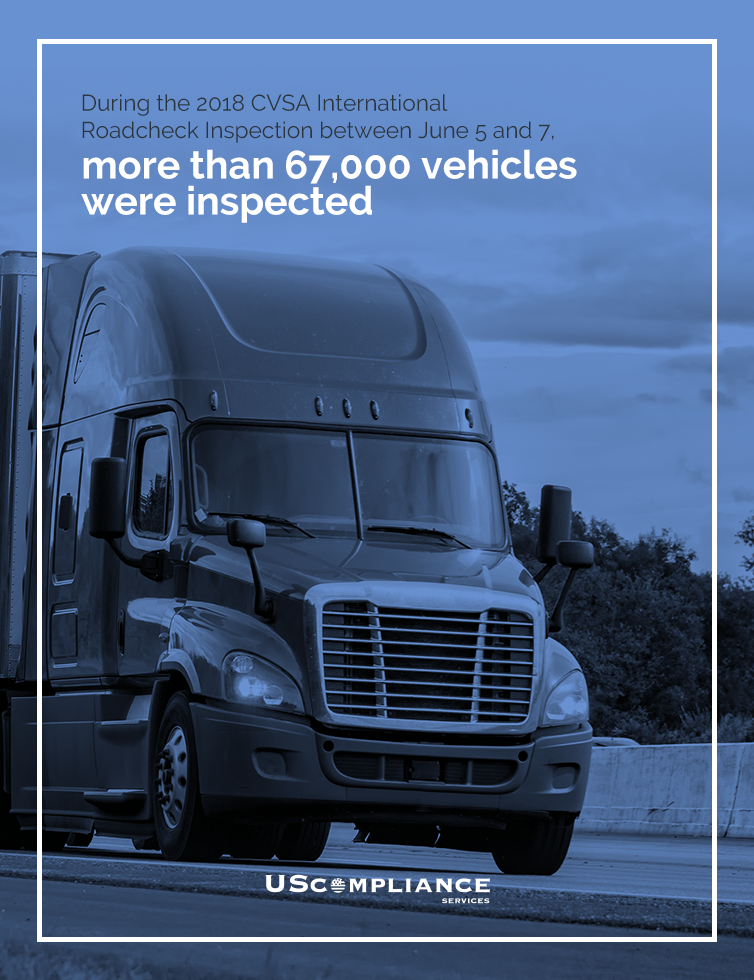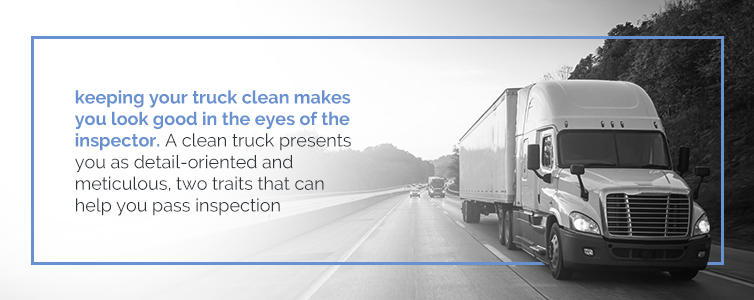Guide to Roadside Inspection for Truck Drivers

The chances are high that at one time or another during your trucking career, you’ll pull your rig into a weight station and be flagged down by the resident inspector. They’ll ask you to pull off to the side of the road, and their judgment can make or break you as a driver. These events can be nerve-wracking, but they’re part of driving a truck in the United States. What are roadside inspections, what do they entail and how can you survive with your sanity intact? Read on for our comprehensive guide to roadside inspections to help you thrive as a trucker in the U.S.
What Are Roadside Inspections?
First, what are roadside inspections and why do they happen?
Roadside inspections are regular and often random inspections of commercial motor vehicles and their drivers. Inspectors from the Motor Carrier Safety Assistance Program (MCSAP) conduct the inspections. Contrary to popular belief, these inspections aren’t designed to make your life harder or cause you to miss a delivery deadline. They’re designed to reduce the number of large truck accidents on the road, making it safer for drivers everywhere.

Roadside inspections happen for a variety of reasons. You could just be the lucky driver coming through the weigh station that happens to tick that “pull off for inspection” box on the inspector’s sheet. Unsafe behaviors behind the wheel, such as using your cell phone, not wearing your seatbelt or driving aggressively, might also result in an inspection. The Commercial Vehicle Safety Alliance (CVSA) also holds an inspection blitz during the first week of June every year to see how drivers stack up. Everyone gets pulled off for a roadside inspection now and then. What should you expect during yours?
What to Expect During a Roadside Inspection
First, it’s important to know that there are eight different levels of inspection, depending on the situation and the cargo.
- North American Standard Inspection: This is the most comprehensive roadside inspection, with 37 steps that look at both the truck and the driver. The inspector will go over the vehicle from stem to stern, including underneath the chassis and under the hood.
- Walk-Around Driver and/or Vehicle Inspection: The inspector can choose to look at you, your vehicle or both. They won’t climb under the truck, just check out the things they can see with a casual inspection.
- Driver Credential Inspection: They won’t look at your truck, just at you or your drivers.
- Special Inspections: These tend to be one-off inspections and may be in place to study a specific trend. They may also be in place to support or refute a specific study if the need arises.
- Vehicle Only Inspection: This includes all of the vehicle-inspection steps from the standard Level I inspection, without looking at driver credentials.
- Inspection for Transuranic Waste and Highway Route Controlled Quantities of Radioactive Materials: This only applies if you’re hauling radioactive waste.
- Jurisdictional Mandated Commercial Vehicle Inspection: This doesn’t typically apply to truckers and is usually reserved for other commercial vehicles like school buses and shuttles.
- Electronic Inspection: This is fairly new and allows inspectors to carry out their job without interacting with the truck or driver. It can be done wirelessly, even while the truck is on the road.
Many truckers only recognize six of these eight inspection types, because Level VII doesn’t apply to commercial truck drivers and Level VIII is relatively new and hasn’t been adopted in all circles. That may change as electric logging devices become more widespread. It won’t replace a physical inspection of the vehicle when necessary, but it is useful for ensuring hours of service compliance and other digital data.
What inspection procedures should you expect to encounter?
First, you’ll be asked to pull over. If you’re in a weigh station, they might have a designated inspection area. If not, you may find yourself pulling off to the side of the road.
Depending on the inspection level, you may need to exit the vehicle and receive further instruction from the inspector. If you pass the inspection, you can continue on your way. If you fail, you risk being given an “out of service” status, which means you can’t continue to work until the problems are resolved. What do you need to know to ensure that you always pass your roadside inspections?
Roadside Inspection Tips
During the 2018 CVSA International Roadcheck Inspection between June 5 and 7, more than 67,000 vehicles were inspected. Of that number, 21% were placed out of service due to the result of their Level I inspection. That includes 11,910 vehicles and 2,666 drivers. In 2019, the International Roadcheck Inspection fell between June 4 and 6. They inspected 67,072 vehicles, and the numbers climbed between 2018 and 2019, with 12,109 vehicles and 2,784 drivers placed out of service.
While roadside inspections aren’t usually this comprehensive, and this was part of an enforcement initiative, inspections are part of every single truck driver’s career at one point or another. They can be annoying, but they aren’t anything to be afraid of. Here are a few tips and tricks to help you pass every roadside inspection between now and retirement, and to help keep you from becoming one of those statistics. Consider it your roadside inspection checklist.
1. Know and Obey Local Traffic Laws
First, make sure that you’re obeying all traffic laws for whatever state you’re traveling in. Pay close attention to road signs and traffic signals, and don’t speed. Wear your seatbelt and, whatever you do, don’t text and drive. Most states have made using your cellphone behind the wheel a primary offense so police officers can pull you over for it without any other reason. When you’re behind the wheel of a truck, you’re essentially driving an 80,000-pound bomb, so driver and vehicle safety is essential.
Remember that local cellphone laws may apply to more actions than texting or holding the phone up to your ear and talking. Even reaching for your phone can be an infraction if the motion causes you to shift out of an upright, seated position.
2. Maintain ELD Compliance
Next, make sure you are compliant with the electronic logging device (ELD) mandate, which went into full effect on December 2017. Ensure that you and your vehicle are ELD compliant if you’re pulled over for an inspection. The only vehicles exempt from ELD are tow-trucks, vehicles built before 2000, and drivers who maintain logs for fewer than eight days out of the month.
To maintain full ELD compliance, you will need to have a functional ELD in your vehicle and keep that device powered on and working at all times. You’ll likely also want to choose a device that uses USB or Bluetooth connections for data transfer. If you rely on a cellular connection and drive through an area with no service, the engine data will not sync with your phone, and you could be out of compliance at your next driver inspection.
3. Keep Paperwork Organized and Available
Have all of your paperwork in good order and available for the inspector to look over. This might include but isn’t limited to:
- Seatbelt exemption paperwork, if applicable
- Medical card and waiver, if applicable
- Your medical examiner’s certificate
- Your commercial driver’s license
- Your skill performance evaluation (SPE) certificate
- Your continuing professional education (CPE) certificate
- Your hours of service (HOS) compliance records
- Your record of duty status (RODS)
All of these items are included in the Level I inspection.
4. Keep Your RODS and HOS in Compliance
Speaking of RODS and HOS, you need to ensure that both are in compliance since missing either or both could result in you or your vehicle being marked as out of service.
For RODS compliance, you’ll need to log your completed hours every 24 hours. For HOS compliance, monitor your driving time and be careful not to exceed the maximum permitted consecutive hours. You’ll also need to take the mandated rest breaks and days off. The push toward using ELDs makes it easier for drivers to maintain HOS compliance, since the devices log engine activity automatically.
5. Become Proficient With Your ELD Equipment
You also need to know how to use whatever ELD equipment is installed in your truck. During a roadside inspection, you will likely be asked to email your ELD records to the inspector. Not knowing how to do this could take you out of service for non-compliance.
You’ll also need to know how to certify your RODS as complete and how to annotate them as necessary. Failure to certify properly will raise questions for the inspector.
6. Inspect Your Truck Before Every Trip
Experts recommend doing your own inspection before you leave on each trip. A thorough inspection can alert you to any potential problems that might make you a target for a roadside inspection or leave you stranded on the side of the road. According to Jason Morris, a Kentucky State Police Sargent, something as simple as a dirty windshield could make you a target. The Federal Motor Carrier Safety Administration (FMCSA) recommends a customizable Driver’s Vehicle Inspection Report on their website that gives you a good place to start.
During each required pre-trip walkaround, be sure to check the tires, braking system, headlights and other essential features of your vehicle. You should also be sure you have an emergency kit that contains working fuses, hazard triangles and a functional fire extinguisher.
7. Keep Your Vehicle Clean
Speaking of dirty windshields, make it a point to keep your truck clean — inside and out. This has two purposes. First, a clean truck makes it easier for the inspector to do their job. It’s hard to tell if something is worn out or getting ready to break if it’s covered with an inch or two of road grime. Second, keeping your truck clean makes you look good in the eyes of the inspector. A clean truck presents you as detail-oriented and meticulous, two traits that can help you pass inspection.

When inspectors check cabs for cleanliness, they often look for signs of drug and alcohol use as well. Never keep drugs or alcohol in your vehicle or use them on the job. You will want to be careful not to give the appearance of doing so — be sure to clean up any burn marks, stains or spills that could suggest the presence of illicit substances.
8. Look Through the CVSA Roadside Inspection Manual
The CVSA doesn’t want to take drivers off the road by declaring them out of service, either during their annual roadside inspection event or throughout the year. Their goal is to make the roads safer by ensuring that drivers and their vehicles are safe to be on the road.
With that in mind, they’ve prepared a comprehensive inspection manual that fleet managers, drivers and others can use to ensure that all of their vehicles are ready for any and all inspections that they might encounter. It’s worth taking a little time to become familiar with the manual, learn more about inspection items and incorporate some of its advice into your roadside inspection checklist. You’ll get the latest tips on preparing for driver inspections and make yourself feel more comfortable when you receive one.
9. Seek Professional Guidance
If you’re not sure if all your T’s are crossed the way they should be, consider consulting a professional to ensure that you’re in compliance with all local, state and federal laws. Compliance specialists spend their days and nights helping drivers and companies navigate challenging paperwork and forms. That way, drivers can do what they do best — get out on the highway.
The best advice we can offer above everything that we’ve mentioned here is simply to be prepared. Many of the things that will mark you as out of service can be prevented by regular maintenance and inspections. Be prepared, follow the rules of the road and the specific laws for whatever state or states you’re driving through. You’ll still experience the occasional inspection, but being prepared and taking care of your vehicles can lower your chances of being marked out of service until the problems are fixed.
Importance of Being Prepared for Roadside Inspections
Why is it so important to be prepared for roadside inspections?
First, it’s critical because these inspections are a part of the industry. Even the safest driver will get chosen for a roadside inspection during their career. It isn’t something to be ashamed of or afraid of. It is simply a fact of life for anyone with a CDL who drives a truck.
If you’re not prepared, you risk being marked out of service. This has several negative effects. First, being out of service means that you can’t get back on the road until the problems are resolved. If you’re pulled over in the middle of a delivery run, someone else will have to come take your load while you try to fix whatever caused the problems. If the problems are with the driver, a replacement will have to come out and finish the delivery. Any way you look at it, being marked out of service is going to upset your schedule and make it more challenging to keep to your deadlines.
Inspection tickets often come with a hefty monetary penalty. If you work for a trucking company, the penalty might be billed to them. If you’re working for yourself as an owner and operator, you’ll be responsible to pay the fines.
There is also the problem of the CSA points that you’ll acquire for failing an inspection. CSA stands for Compliance, Safety and Accountability. Any time a commercial driver violates the law behind the wheel of a truck, they’re assigned points. This includes traffic violations, e-log violations and much more. The higher a driver’s CSA score, the riskier the FMCSA considers them. Individual drivers and fleets want to have the lowest CSA score possible. If you’re not prepared for roadside inspections, you’ll see your CSA score climb skyward.
If you’re hauling hazardous materials, there are additional risks to consider. Hazmat haulers risk more than 300 misdemeanor charges if they can’t pass a roadside inspection. Serious offenses can even sideline a driver permanently, regardless of how skilled they are behind the wheel.
Finally, if you’re not prepared for a roadside inspection, it could be argued that you’re not ready to be on the road at all. A truck that can’t pass a random inspection, whether it’s during the CVSA’s annual blitz or during an average workday, may not be safe to drive. The same goes for drivers who can’t pass their own inspections.
Avoid Violations With US Compliance Services
Roadside inspections have always been and will always be part of being a truck driver in the United States. There is no shame in getting waved off for an inspection — only in failing one. The adage goes like this — proper preparation prevents poor performance. That goes double for drivers and their trucks. Make it a point to be as prepared as possible for any potential inspection. Drivers should always have all of their paperwork handy and know how to manage their ELD to forward the data contained within to an inspector. Trucks should be inspected before and after each trip to ensure that they’re in compliance.
If you’re worried about failing a roadside inspection or being taken out of service, give US Compliance Services a call or contact us online. We’re here to help you navigate everything from inspections to FMSCA compliance and everything in between.

